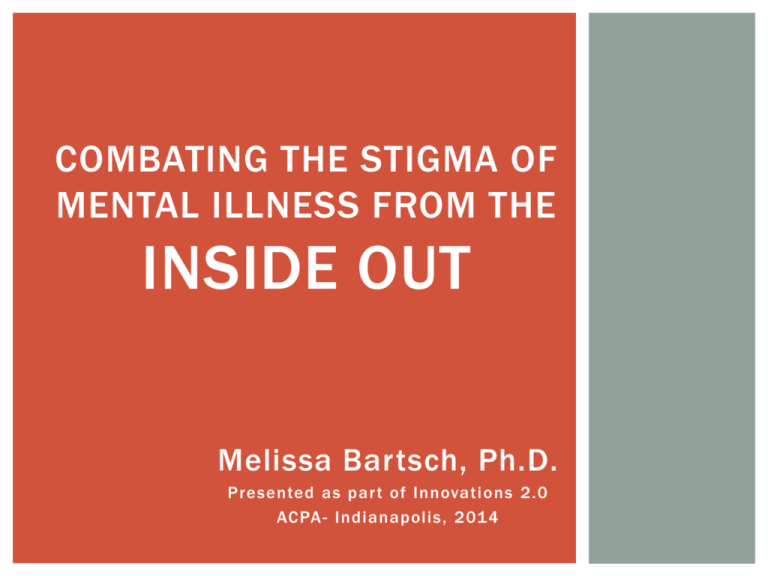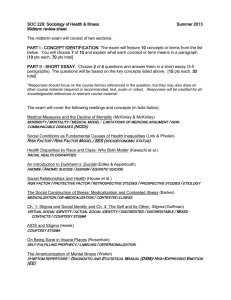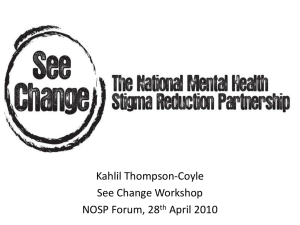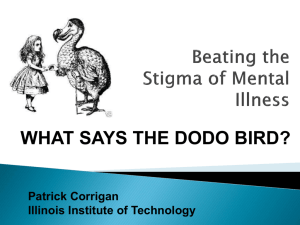PowerPoint - The Universities at Shady Grove
advertisement

COMBATING THE STIGMA OF MENTAL ILLNESS FROM THE INSIDE OUT Melissa Bartsch, Ph.D. Presented as par t of Innovati ons 2.0 ACPA - Indianapolis, 2014 ORIGIN STORY Providing clinical supervision Teaching practicum Conversations with clients Reflections on my own training MENTAL HEALTH STIGMA Negative effects (Couture & Penn, 2003) Low self-esteem Discrimination (employability, leasing) Reluctance to seek treatment Perceived as being responsible for mental illness Exclusion Identified as the number one barrier to mental health treatment by the U.S. Surgeon General (1999) MORE ON STIGMA… Stigmatizing attitudes (Corrigan & Penn, 1999) Fear and exclusion Authoritarianism Benevolence Trained professionals within mental health have stereotypes about mental illness (Lyons & Ziviani, 1995) LEVELS OF INTERVENTION Education (Corrigan & Penn, 1999) Personal info about the individual with mental illness Directly attack myths Involve discussion Increase empathy through simulations Contact (Corrigan, 2001) Perspective-taking (Mann, 2010) Protest (Corrigan & Penn, 1999) OUR TRAINING Modeled after UT’s Safe Zone training curriculum Incorporated effective destigmatization education Second-year Counseling Psychology doctoral students Experiential Activities Stereotypes and Messages Continuum Storyboards Reaction/reflection paper written after the training GOALS Goals Become a mental health ally (inside and out) Among peers and colleagues On campus In session In the community Become inclusive, affirming, and broadening prospective Facilitate dialogue regarding interaction between personal beliefs and professional behavior Discuss ways in which beliefs impact therapy TRAINING STRUCTURE Two groups of 3 3-hour training Experiential activities and dialogue Rules and debriefing Exploration vs. shame Agree to disagree STEREOT YPES AND MESSAGES Diagnoses on large notepad around the room Bipolar Disorder, BPD, Alcohol Dependency, Amphetamine Abuse, GAD, Anorexia, Adjustment Disorder Instructions: List messages received or things believed/heard about each Time: 2 minutes per sheet Discussion Questions: What stands out? What was surprising? CONTINUUM Strongly Agree to Strongly Disagree Instructions: Stand on the continuum after each of the following questions: I would be comfortable referring my clients for medication I would tell my friends I’m in therapy I would be in a relationship with someone who has Bipolar Disorder Discussion Questions: Do you notice any discrepancies regarding what’s o.k. for clients and not o.k. for you? How did I get to this place on the continuum? A TRAINEE’S PERSPECTIVE “I think what really stuck with me was writing down our stereotypes for certain diagnoses. I became really aware how we, as mental health professionals, talk about our clients in sometimes negative ways, and how labels can be damaging because of stigma. After that class, I remember making conscious efforts to talk about my clients as if they were healthy individuals experiencing life difficulties, rather than disordered or diseased people. It was just fun to do, too. Way better than just getting a lecture on stigma =).” ANOTHER TRAINEE’S PERSPECTIVE “One thing that sticks to my mind is that through this activity I was able to acknowledge how my expectations of others as clients is different from my own expectations as a client. It helped me realize that I have my own bias towards others, especially those with psychological disorders, even if these biases are somewhat unconscious. It also provided a more experiential understanding of the fears and stigma tied to psychotherapy and psychotropic medication that many clients probably feel when making the decision to seek help.” COMMUNIT Y INTERVENTION Be flexible Time devoted to discussion versus activities Tailor training to audience Mindfulness of basic knowledge level Language Room for debriefing QUESTIONS FOR THE AUDIENCE • What efforts are being made on your campus to combat mental health stigma? • How might you adapt this destigmatization training to fit your needs? • What sorts of things are you doing on your campus to combat mental health stigma? • What might be some of the challenges of implementing this sort of training with other professions? REFERENCES Byrne, P. (2000). Stigma of mental illness and ways of diminishing it. Advanc es In Psychiatric Treatment, 6, 65 -72. Corrigan, P. & Penn, D (1999). Lessons from social psychology on discrediting psychiatric stigma. American Psychologist, 54 (9), 765-776. Corrigan, P. (2004). How stigma inter feres with mental health care. American Psychologist, 59 (7), 617-625. Couture, S.M. & Penn, D.L. (2003). Interper sonal contact and the stigma of mental illness: A review of the literature. Journal of Mental Health , 1 2 (3), 291-305. Lyons, M. & Ziviani, J. (1995). Stereotyp es, stigma, and mental Illness: Learning from fieldwork experiences. The American Journal of Occupation al Therapy. Mann, C. E. (2010). In a Stranger's Shoes: Reduc ing mental illness stigma through per spec tive -taking. Unpublished doctoral disser tation, Univer sity of Tennessee, Knoxville, TN. Retrieved June 1 , 201 2, from Disser tations and Theses database. RECOMMENDED WEBSITES Changing Minds Campaign http://www.rcpsych.ac.uk/campaigns/changingminds/wh atisstigma/mentaldisorderschallenging.aspx National Alliance for the Mentally Ill (NAMI) http://www.nami.org/template.cfm?section=fight_stigma SAMHSA’s Resource Center to Promote Acceptance, Dignity and Social Inclusion Associated with Mental Health (ADS Center) http://www.stopstigma.samhsa.gov/







